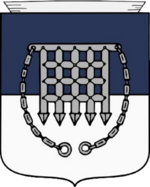Difference between revisions of "Parliament of Hapatmitas"
m (Clerkedfootmen moved page Tiomnaidh to Parliament of Hapatmitas) |
|||
| (4 intermediate revisions by the same user not shown) | |||
| Line 1: | Line 1: | ||
{{Infobox legislature | {{Infobox legislature | ||
| − | | background_color = # | + | | background_color = #2A3657 |
| − | | name = | + | | name = Parliament of the Commonwealth |
| − | | native_name = | + | | native_name = {{nobold|Pàrlamaid a' Cho-fhlaitheis}} |
| transcription_name = | | transcription_name = | ||
| − | | legislature = | + | | legislature = [[20th Session of the Parliament of Hapatmitas|20th Parliament of Hapatmitas]] |
| coa_pic = Coat of arms of Hapatmitas.png | | coa_pic = Coat of arms of Hapatmitas.png | ||
| coa_alt = | | coa_alt = | ||
| Line 16: | Line 16: | ||
| foundation = {{Start date and age|1950|8|4|df=y|p=1|br=1}} | | foundation = {{Start date and age|1950|8|4|df=y|p=1|br=1}} | ||
| disbanded = | | disbanded = | ||
| − | | preceded_by = National Congress | + | | preceded_by = [[National Congress of Hapatmitas|National Congress]] |
| succeeded_by = | | succeeded_by = | ||
| new_session = 5 August 2023 | | new_session = 5 August 2023 | ||
| Line 22: | Line 22: | ||
| leader1 = {{nowrap|[[Patrick Marwick]]}} | | leader1 = {{nowrap|[[Patrick Marwick]]}} | ||
| election1 = 4 August 2023 | | election1 = 4 August 2023 | ||
| − | | leader2_type = [[President of the National Assembly (Hapatmitas)| | + | | leader2_type = [[President of the National Assembly (Hapatmitas)|Speaker of the National Assembly]] |
| − | | leader2 = {{nowrap|[[Ken | + | | leader2 = {{nowrap|[[Ken Paine]]}} |
| election2 = 4 August 2020 | | election2 = 4 August 2020 | ||
| leader3_type = [[Prime Minister of Hapatmitas|Prime Minister]] | | leader3_type = [[Prime Minister of Hapatmitas|Prime Minister]] | ||
| Line 39: | Line 39: | ||
| structure2 = File:Tiomnaidh – Seanadh Nàiseanta diagram.svg | | structure2 = File:Tiomnaidh – Seanadh Nàiseanta diagram.svg | ||
| structure2_res = 300 | | structure2_res = 300 | ||
| − | | political_groups1 = '''Government ( | + | | political_groups1 = '''Government (63)''' |
:{{color box|#24509C|border=darkgray}} [[National Democratic Union (Hapatmitas)|National Democratic Union]] (34) | :{{color box|#24509C|border=darkgray}} [[National Democratic Union (Hapatmitas)|National Democratic Union]] (34) | ||
:{{color box|#2489BD|border=darkgray}} [[Christian Democrats (Hapatmitas)|Christian Democrats]] (22) | :{{color box|#2489BD|border=darkgray}} [[Christian Democrats (Hapatmitas)|Christian Democrats]] (22) | ||
:{{color box|#B500B5|border=darkgray}} [[Moderate Alliance of Hapatmitas|Moderate Alliance]] (7) | :{{color box|#B500B5|border=darkgray}} [[Moderate Alliance of Hapatmitas|Moderate Alliance]] (7) | ||
| − | + | '''Opposition (92)''' | |
| − | '''Opposition ( | ||
:{{color box|#F23030|border=darkgray}} [[Social Democratic Party (Hapatmitas)|Social Democrats]] (39) | :{{color box|#F23030|border=darkgray}} [[Social Democratic Party (Hapatmitas)|Social Democrats]] (39) | ||
:{{color box|#FFDC40|border=darkgray}} [[Progressive Future Party (Hapatmitas)|Progressive Future Party]] (18) | :{{color box|#FFDC40|border=darkgray}} [[Progressive Future Party (Hapatmitas)|Progressive Future Party]] (18) | ||
| Line 50: | Line 49: | ||
:{{color box|#DEA221|border=darkgray}} [[Social Solidarity Party (Hapatmitas)|Social Solidarity Party]] (7) | :{{color box|#DEA221|border=darkgray}} [[Social Solidarity Party (Hapatmitas)|Social Solidarity Party]] (7) | ||
:{{color box|#B53F63|border=darkgray}} [[People's Action Party (Hapatmitas)|People's Action Party]] (2) | :{{color box|#B53F63|border=darkgray}} [[People's Action Party (Hapatmitas)|People's Action Party]] (2) | ||
| + | :{{color box|#B1B6BD|border=darkgray}} Non-attached (17) | ||
| + | :* {{color box|#B1B6BD|border=darkgray}} [[Independent politician|Independent]] (17) | ||
| political_groups2 = '''Government (244)''' | | political_groups2 = '''Government (244)''' | ||
:{{color box|#24509C|border=darkgray}} [[National Democratic Union (Hapatmitas)|National Democratic Union]] (120) | :{{color box|#24509C|border=darkgray}} [[National Democratic Union (Hapatmitas)|National Democratic Union]] (120) | ||
| Line 62: | Line 63: | ||
:{{color box|#B1B6BD|border=darkgray}} Non-attached (5) | :{{color box|#B1B6BD|border=darkgray}} Non-attached (5) | ||
:* {{color box|#B1B6BD|border=darkgray}} [[Independent politician|Independent]] (5) | :* {{color box|#B1B6BD|border=darkgray}} [[Independent politician|Independent]] (5) | ||
| − | | voting_system1 = | + | | voting_system1 = Open-list proportional representation |
| voting_system2 = Mixed-member proportional representation (MMP) | | voting_system2 = Mixed-member proportional representation (MMP) | ||
| last_election1 = [[2023 Hapatmitasian legislative election|7 July 2023]] | | last_election1 = [[2023 Hapatmitasian legislative election|7 July 2023]] | ||
| Line 68: | Line 69: | ||
| next_election3 = [[Next Hapatmitasian legislative election|By June 2027]] | | next_election3 = [[Next Hapatmitasian legislative election|By June 2027]] | ||
| motto = | | motto = | ||
| − | | session_room = File:2011-06-11 | + | | session_room = File:2011-06-11 02 Parliament House of Sweden (Riksdagshuset) in Gamla Stan, Stockholm.jpg |
| session_res = 280px | | session_res = 280px | ||
| − | | session_alt = | + | | session_alt = North entrance of Parliament House |
| − | | meeting_place = Parliament House, | + | | meeting_place = [[Parliament House, Donideann|Parliament House]], Seilgtaigh, [[Donideann]] |
| constitution = [[Constitution of Hapatmitas]] | | constitution = [[Constitution of Hapatmitas]] | ||
| website = | | website = | ||
}} | }} | ||
{{Politics of Hapatmitas}} | {{Politics of Hapatmitas}} | ||
| − | The ''' | + | The '''Parliament of Hapatmitas''' ([[Cantuath language|Cantuath]]: ''Pàrlamaid na Hapatmitas''), officially the '''Parliament of the Commonwealth''' (Cantuath: ''Pàrlamaid a' Cho-fhlaitheis''), is the supreme bicameral legislature of [[Hapatmitas]], established in 1950 by the [[Constitution of Hapatmitas]]. It is also referred to by the metonym ''Seilgtaigh''. Parliament consists of [[Senate of Hapatmitas|Senate]] and the [[National Assembly (Hapatmitas)|National Assembly]]. Though the Senate is the upper house, the Constitution vests the National Assembly with slightly more power, forming a near-perfect bicameral system. |
| − | + | The upper house, the Senate, consists of 155 members: fifteen for each [[Provinces of Hapatmitas|province]], except for [[Rinnfriu-Dunphris]] which is allocated twenty instead, after the [[2015 Hapatmitasian general election|2015 general election]]. An elected individual in the Senate is known as a senator (''seanairean''). Senators are exclusively elected by a specific province's populace via open-list proportional representation every four years. They can also be recalled by their provincial constituents if there is a majority in a locally petitioned referendum. Because the Senate uses a proportional system to elect its members, the number of senators may differ each election. Since [[1991 Hapatmitasian general election|1991]], no single party or coalition has held a majority in the Senate. However, the party or coalition that holds the majority in the National Assembly will become the government in the Senate, though they will require multi-partisan negotiations to pass legislation onto the [[President of Hapatmitas|President]] for assent into law. | |
| − | + | The lower house, the National Assembly, consists of 485 members elected by mixed-member proportional representation. An elected individual in the National Assembly is known as a ''Ball den Pàrlamaid'' (BdP). BDPs are elected from their single-member constituencies. Like their counterparts in the Senate, BdPs can be recalled by a referendum. Additionally, like the Senate, the number of seats in the National Assembly may differ each election, depending on the boundary reviews of the [[Elections and Boundaries Commission (Hapatmitas)|Elections and Boundaries Commission]]. The [[Council of Ministers (Hapatmitas)|Council of Ministers]] have traditionally answered to the lower house by convention and hence its members have derived from it. | |
| − | The | + | |
| + | Both houses of parliament, since their establishment, have met in separate chambers of the East Building in [[Parliament House, Donideann|Parliament House]] in [[Donideann]]. The West Building is a formal museum, though it was formerly used for the offices of senators and BdPs. During the election of the President of Hapatmitas, the East Building is temporarily reconfigured to fit the seven hundred electors. | ||
== History == | == History == | ||
| − | |||
| − | |||
| − | + | == Composition == | |
| + | === 20th Parliament === | ||
| + | {{main|20th Session of the Parliament of Hapatmitas}} | ||
| − | In | + | === Membership and structure === |
| − | + | The number of seats in Parliament has changed since its establishment in 1950 due to the proportional representation electoral systems and varied electoral reforms. In 1950 there were provisionally 50 seats in both houses, increasing to 72 BTs and 48 senators in 1951 after the [[1951 Hapatmitasian legislative election|first legislative election]], 109 BTs and 68 senators after the [[1963 Hapatmitasian legislative election|1963 election]], 140 BTs and 95 senators after the [[1975 Hapatmitasian legislative election|1975 election]], 240 BTs and 102 senators after the [[1991 Hapatmitasian legislative election|1991 election]], 360 BTs and 120 senators after the [[2007 Hapatmitasian legislative election|2007 election]], and 485 BTs and 155 senators as of [[2015 Hapatmitasian legislative election|2015]]. | |
| − | |||
| − | |||
| − | |||
== Notes == | == Notes == | ||
Latest revision as of 00:08, 14 May 2024
Parliament of the Commonwealth Pàrlamaid a' Cho-fhlaitheis | |
|---|---|
| Type | |
| Type | Bicameral |
| Houses | Senate National Assembly |
| History | |
| Founded | 4 August 1950 |
| Preceded by | National Congress |
New session started | 5 August 2023 |
| Leadership | |
Patrick Marwick since 4 August 2023 | |
Ken Paine since 4 August 2020 | |
Doug Macintosh since 13 April 2024 | |
Tom McIntyre since 27 October 2023 | |
| Structure | |
| Seats | 640 155 (Senate) 485 (National Assembly) |
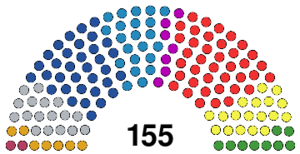 | |
Senate political groups | Government (63)
Opposition (92)
|
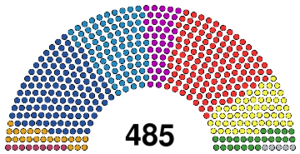 | |
National Assembly political groups | Government (244)
Opposition (241)
|
| Elections | |
| Open-list proportional representation | |
| Mixed-member proportional representation (MMP) | |
Senate last election | 7 July 2023 |
National Assembly last election | 14 July 2023 |
Next general election | By June 2027 |
| Meeting place | |
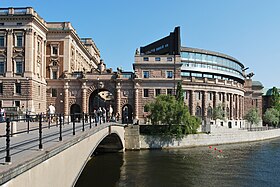 | |
| Parliament House, Seilgtaigh, Donideann | |
| Constitution | |
| Constitution of Hapatmitas | |
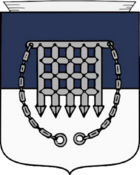 |
|---|
| This article is part of a series on the politics and government of Hapatmitas |
The Parliament of Hapatmitas (Cantuath: Pàrlamaid na Hapatmitas), officially the Parliament of the Commonwealth (Cantuath: Pàrlamaid a' Cho-fhlaitheis), is the supreme bicameral legislature of Hapatmitas, established in 1950 by the Constitution of Hapatmitas. It is also referred to by the metonym Seilgtaigh. Parliament consists of Senate and the National Assembly. Though the Senate is the upper house, the Constitution vests the National Assembly with slightly more power, forming a near-perfect bicameral system.
The upper house, the Senate, consists of 155 members: fifteen for each province, except for Rinnfriu-Dunphris which is allocated twenty instead, after the 2015 general election. An elected individual in the Senate is known as a senator (seanairean). Senators are exclusively elected by a specific province's populace via open-list proportional representation every four years. They can also be recalled by their provincial constituents if there is a majority in a locally petitioned referendum. Because the Senate uses a proportional system to elect its members, the number of senators may differ each election. Since 1991, no single party or coalition has held a majority in the Senate. However, the party or coalition that holds the majority in the National Assembly will become the government in the Senate, though they will require multi-partisan negotiations to pass legislation onto the President for assent into law.
The lower house, the National Assembly, consists of 485 members elected by mixed-member proportional representation. An elected individual in the National Assembly is known as a Ball den Pàrlamaid (BdP). BDPs are elected from their single-member constituencies. Like their counterparts in the Senate, BdPs can be recalled by a referendum. Additionally, like the Senate, the number of seats in the National Assembly may differ each election, depending on the boundary reviews of the Elections and Boundaries Commission. The Council of Ministers have traditionally answered to the lower house by convention and hence its members have derived from it.
Both houses of parliament, since their establishment, have met in separate chambers of the East Building in Parliament House in Donideann. The West Building is a formal museum, though it was formerly used for the offices of senators and BdPs. During the election of the President of Hapatmitas, the East Building is temporarily reconfigured to fit the seven hundred electors.
History
Composition
20th Parliament
Membership and structure
The number of seats in Parliament has changed since its establishment in 1950 due to the proportional representation electoral systems and varied electoral reforms. In 1950 there were provisionally 50 seats in both houses, increasing to 72 BTs and 48 senators in 1951 after the first legislative election, 109 BTs and 68 senators after the 1963 election, 140 BTs and 95 senators after the 1975 election, 240 BTs and 102 senators after the 1991 election, 360 BTs and 120 senators after the 2007 election, and 485 BTs and 155 senators as of 2015.
